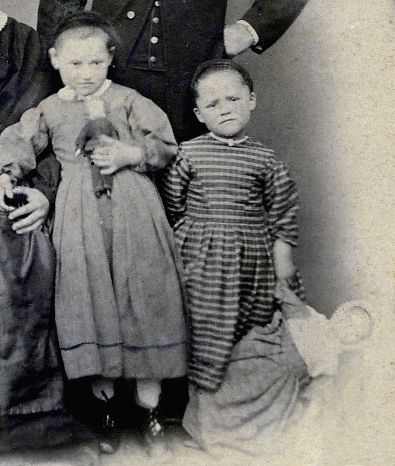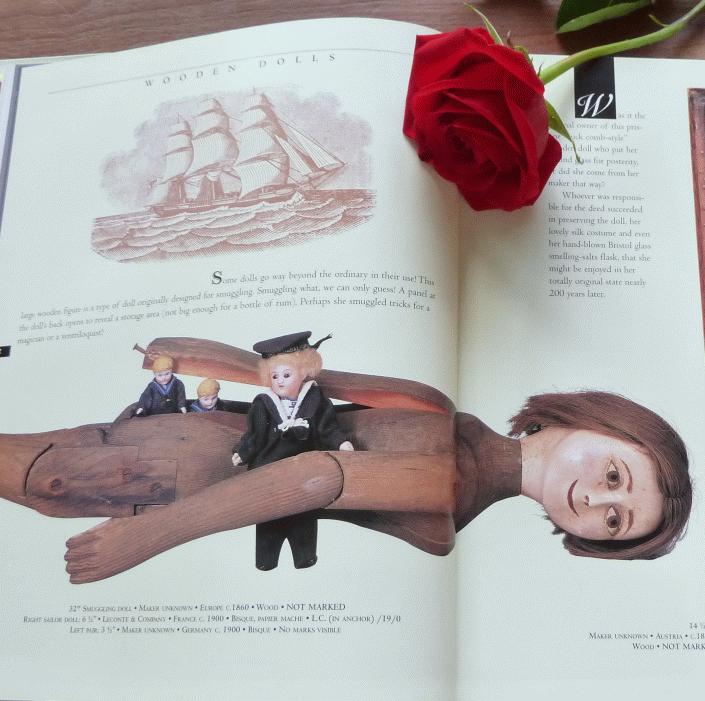 Dolls were an especially big deal in Germany, a full-fledged industry. This photo, taken in Freinsheim, Germany around 1870, shows Elizabetha and Margaretha Harm, the daughters of Philipp and Susanna Harm, holding their dolls. I thought of this photo recently on a visit to the Rosalie Whyel Museum of Doll Art in Bellevue, Washington.
Dolls were an especially big deal in Germany, a full-fledged industry. This photo, taken in Freinsheim, Germany around 1870, shows Elizabetha and Margaretha Harm, the daughters of Philipp and Susanna Harm, holding their dolls. I thought of this photo recently on a visit to the Rosalie Whyel Museum of Doll Art in Bellevue, Washington.
I attended with my historical fiction writer friend Michele.
“I hear the museum’s going to close its doors,” Michele said, “and I’ve always meant to go back. It’s an amazing resource for historical clothing styles and customs.”
What a great idea. At the Museum of Doll Art’s front counter, Michele zeroed in on a gorgeous book called The Rose Unfolds: Rarities of the Rosalie Whyel Museum of Doll Art.
“See? This is what I mean,” she said, pointing at a photo of one of the treasures, a doll from the Regency era. “You can learn so much about the clothing and fabrics of the period.”
“That book is half-off right now,” the woman at the counter said.
“I might just buy it. Are you really closing?”
“March 1st.”
“What’s going to happen to all the dolls?”
“We’re not sure yet — they’ll probably go into storage for a while.”
Photography was not permitted, and it’s hard to capture the marvels of that doll-populated world. Imagine the best doll house you ever saw, each room meticulously arranged with rag rugs, tiny stuffed furniture, glowing logs, a porcelain cat by the fireplace, father, mother, and kids posed in  various rooms, and take it to the nth power. Circus dolls, peddler dolls, international dolls, Kewpie dolls, dolls made of wax and wood and bisque and cloth. Dolls in toy Studebaker wagons and riding on horseback. Dolls of England’s royal family, dolls selling miniature hospital supplies, even opium-smoking dolls. Many of the dolls on display were created by German artisans: J.D. Kestner, Hertwig, Heubach, and Simon & Halbig.
various rooms, and take it to the nth power. Circus dolls, peddler dolls, international dolls, Kewpie dolls, dolls made of wax and wood and bisque and cloth. Dolls in toy Studebaker wagons and riding on horseback. Dolls of England’s royal family, dolls selling miniature hospital supplies, even opium-smoking dolls. Many of the dolls on display were created by German artisans: J.D. Kestner, Hertwig, Heubach, and Simon & Halbig.
I learned from one display that, in the days prior to the fashion plates in magazines, dolls were used as models of the latest fashions. They were dressed in haute couture, crated, and carefully shipped on the open seas. In naval confrontations, there even existed a prohibition against firing on ships with the valuable doll cargo in their holds. The photo here — one page of The Rose Unfolds — is of a wooden doll used for smuggling — she has a compartment in her back for hiding contraband.
